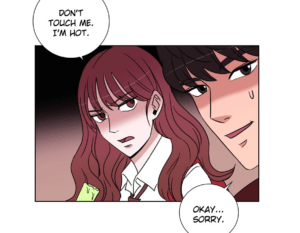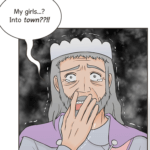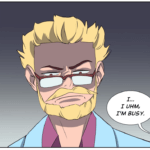Insta Made Me Read It is a twice-monthly column covering the webtoons advertised by LINE Webtoon on their Instagram account and on their app. The focus is on what’s both popular and encouraged to be popular by the publisher-platform itself. This time, I’ve been reading Scorching Romance and Let’s Play. Both are romance-themed comics with pale, brunette female protagonists.
Scorching Romance appeared on the Instagram account early in July, given the benefit of a motion-based promo. It’s not the fully animated shorts that a couple of series (Let’s Play included) have been given, but it’s certainly both eye-catching and focus-pulling. Scorching Romance is a series my sweetie picked for me when I asked for some input.
Let’s Play does, as mentioned, have some animated shorts adapted from its content to promote the series. These are “fully” animated, as in they’re re-drawn scenes rather than “motion comic” or 1960s Marvel-cartoon style reused panels with partial drift. These were advertised on WebtoonOfficial at the end of August and the beginning of September, and Let’s Play‘s return from hiatus was also advertised there earlier in August. But in fact, this isn’t the reason I chose to read Let’s Play! Kim Estlund, LINE Webtoon’s publicist, got in contact after seeing this column and suggested I give Let’s Play a try.
Scorching Romance by Hongchi
Scorching Romance is a grower more than a shower: in the first few chapters there’s very little to recommend it and plenty to put a casual dipper off. But by the time I was twelve chapters in—as I was reading for science, not leisure—I was a little bit infatuated.
Ember is seventeen years old and long-used to her status as too hot. Not too attractive, not too dazzling; literally too hot, as her body temperature is uniquely high. As we meet her, she’s schlepping to school in slides and a sweaty uniform skirt and shirt, while the classmates and schoolmates around her shiver in their coats, boots, and scarves. Ember is a pretty horrible girl, and this doesn’t change—she’s a big bitch, in short terms, a constantly aggravated bully with exactly one friend and an absent inclination toward apology. She insists everyone around her help her to get cooler, and berates them if they demur. She demands the classroom stay unheated in deepest winter, and takes a chair by the heater to ensure nobody can turn it on. She treats that one friend of hers as badly as she treats everyone else, and he doesn’t mind, only passes her a popsicle.
Ember isn’t drawn to be beautiful, and nobody treats her as such. More importantly, her lack of grace, social and otherwise, is artistically foregrounded. To tip the hat, this comic could (honestly, would better) have been called Sweatgirl. Ember is an average-looking person with bad behaviour, bad etiquette, and a bad personality. A genuinely dislikeable heroine. It scratches a pretty deep itch.
The art in a wider sense is fairly neutral, full of straight lines of undifferentiated weight, fairly basic gradients and the bare minimum indication of hair shine. Shading only exists on skin, making the school uniforms the characters usually wear even more decidedly uniform. The aesthetic exists as a plateau on which certain statements can be built: this character is the uguu type, that character is an unnerving style maven, the other is (is there a word, specifically, for ungraceful?). And this is a story about touching. So Ember’s earthiness is the first indication of what makes Scorching Romance stand out, both as singular entertainment and an object of study. That is, its status as a girls’ power fantasy.
Ember is a bad person, and she’s seventeen years old. She’s annoyed all the time and resents everybody she knows. Have you been there? I know that I have. Ember acts out to her heart’s discontent, going not without punishment or without judgement, but without apparent discouragement. It’s clear nobody likes her, and it’s clear why: because (as Fez once said to Jackie Burkhart) she’s unpleasant. She doesn’t do anything to make people like her, and so they don’t. Sometimes a body really needs to be shown that one minus one equals zero—seeing that equation laid out is a satisfying relief, because it’s true. Being reminded via fiction that we don’t cut loose and go apeshit IRL for reasons that are actual and good can be helpful. But that alone would make this comic a PSA, and egregiously worthy, so it’s lucky this is not the whole of the cake.
After various hijinks and happenstances, Ember discovers that she’s under a curse that’s going to kill her. She’s not just a too-hot girl for no reason—she’s eventually going to boil up and expire because somebody mysteriously wants her to. To save or prolong her own life she has to do two things: start mastering her temper, and find somebody with an excess of cold water energy that matches her excess of fire … and kiss them. Ember thinks that both of these suggestions are dreadful, just unreasonable, and that curses are stupid. But she doesn’t want to die. Enter Aspen.
Aspen is a new boy in Ember’s class, and he’s clearly the cold water spirit she’s after. He’s also under a curse, but his works the opposite way, and was cast on him through no fault of his own. Aspen needs external heat sources to survive just like Ember needs external cooling—cue a battle of wills over the classroom heater when they’re assigned seats next to each other. Except Aspen doesn’t have a will when it comes to upsetting other people! He’s the sweetest, an absolute compassion machine, and he’s also very small, always bundled up, with a smooth little rounded face. Basically, he’s baby. Here’s where the rest of the teen girl power fantasy kicks in. When Ember and Aspen touch each other, they experience the normalised temperatures they each haven’t felt in over a decade. This is shocking to both of them, but it’s most impactful on Aspen: not only does his heart start thumping, but he actually physically grows.
Having stayed at the same height for the last four years, i.e. never having experienced the expected puberty growth spurt, due to his maximum of chill, Aspen rapidly expands during an accidental co-sleep on the roof of the school.
Picture the scene: you’re the nastiest girl in the world, and the nicest, puppy-boy darling, who forgives you for everything and only wants to help you stay cool; who believes—which even you had absolutely no suspicion of—that your bad attitude is due to your constant discomfort, is suddenly hulk-busting out of his little-boy trousers and puffa, suddenly taller than you, suddenly has shoulders this wide—and still has his innocent, big-eyed face at the top of this brand new mountain, that’s looking at you with nothing but admiration. The reader also happens to know that being treated rudely by Ember makes Aspen’s heart go boom. Does this leave you unmoved? Maybe it does, but at least let’s respect the wide swathe of people for whom it would be quite something.
The best thing about the horniness of this comic is that despite its heterosexuality, it’s not surface-level, and it’s not glossy or obvious. You can’t see it at a glance in any normalised cues like upskirts or shower scenes or in the style of rendering. You have to read the work, engage with the sequential nature of the imagery, in order to see it. The message is in the sum total.
The power fantasies and catharsis in this comic sound like mill stones grinding over one another in a back room or a closed brewery, not the crack of a fist or “yahoo!” of a young man. There’s plenty more to recommend it that I haven’t mentioned here, more impatient and disreputable women and ineffable decisions by men. It’s definitely one that will be staying on my subscription list.
Let’s Play by Mongie
Let’s Play opens very well: a character narrates their lifelong love of video games, while the illustration shows them as a child, wearing a very feminine top and fairly feminine hairstyle. There’s no second guessing or apology; simply confidence. Girls be gamin’. The rest of this first chapter is just as strong. In just fifty-seven panels it packs in the entire solid premise of the comic: our heroine, Sam, loves gaming so much she’s grown up to work in tech to fund her side hustle and personal passion as an independent game developer. Her life is going well, positive response to her game is unprecedented … until a hot YouTuber—sawwry, “ViewTuber” (I swear, the worst thing about LINE Webtoon as a platform is its insistence on borking up brand names with absolute irregularity)—plays her game, trashes it, and sends her developer score into the toilet by accidentally inciting the wrath of his fans. Then he moves in next door to her.
That sounds like great drama, right? And it is. It’s just that as things continue, it’s barely 30% of the comic. Let’s Play introduces itself as tightly-reined enemies-to-lovers with a strong #online flavour, but quickly relaxes into a three, four, or five-pronged friendship-group/colleague soap loosely centred upon one floppy character. Sam’s got her rivalry with her neighbour; she’s also got her friends at the coffee shop. She’s got her guild on World of WarQuest (nngh), who she also hangs with irl; she’s got her co-workers at her job, where her father also works. All of these are supporting characters of exactly the same in-out focus. Then neighbour/rival/YouTuber Marshall Law, whose name is unexplained as of fifty-three chapters in—why use a pun if you’re not going to use the pun? Why put a Tekken reference in if you’re not going to reference Tekken? Can we at least get a nod to Samo Hung and Arsenio Hall??—has his own run-ins with many of these characters, as well as a subplot that’s exactly as casually paced as anyone else’s about his relationship with his girlfriend, another You—ViewTuber. Sam has intimate tension with Marshall, Link from the coffee shop, and Charles from work, but which of those three detailed and rock hard torsos she’ll be horrified to find herself pushed up against in any given chapter is basically a toss-up. What I struggle to find is a sense of tension in the narrative at large. What sort of point should I be keen to reach?
Hi ho ho, let’s pause here, and enjoy the ironical sensations. Am I, a critic, disliking a comic about somebody’s (inner) life being ruined when a critic didn’t like their creative product?? Pretty much. But don’t worry: the two situations are not accurately comparable. My cult of personality does not approach that of a pop hunk who deals in audiovisual stimulation, and this comic, which is so well supported by the platform it appears on that their PR agent personally recommended I read it, has so many likes that it’s maxed out the counter on all chapters but the most recent, which as of writing is #81, was posted yesterday, and is at 93,584. Every single other chapter reads as being positively stamped by “99,999+” users. Mongie herself has 44.6k followers on twitter, which is ten times my reach, and the comic even has animated shorts out advertising it, which can’t have been a small investment for the publisher. Earlier this year a Kickstarter to print a first volume (twenty-three chapters, originally estimated to translate to around one hundred and twenty pages but now coming in at maybe two hundred) raised over $230,000 on a $10,000 goal.
Let’s Play is easy enough to read; no translation issues here, like Hooky, and nobody is really off-putting, like the kids in Random Chat. The art is basically frictionless—Questionable Content meets seasonal anime, all about being down to earth yet aspirationally cute. Often the dialogue is quite explainer-text, but this does allow for absolute clarity of theme. The lack of structural tension makes barrelling through seem compelling—being uncompelled (this sounds harsher than it should. What I mean is, reading without having a sense of impending climax) by the text means I’m urgent to find some catharsis, so I keep going. I’ve reached a point where Sam and Link have had one date and could have another, he likes her and she likes him, and I’m feeling like I could pretty much stop. Like, okay—there’s something that’s happened. That feels like a moment? It’s more of an “at last!” than anything else on the screen. That’s not to say that the comic is badly structured absolutely. Each chapter has your basic, appropriate rise and fall, a passing of the baton from now to then. It’s not a bad comic. It’s just not the comic it seems like as it opens, and it’s just not a comic that I love.
It is a responsible comic, and a compassionate one. Thanks to Mongie’s life experience in both tech and YouTube (she has a channel of her own, previously drew promo for both games and gamer Markiplier, and worked as a website builder for a decade), it knows what it’s about, both in terms of specialist language, understanding of the various characters’ jobs, and in observing their frailties without scoffing at them. None of the characters exist to be hated or looked down on, and the founding premise, that joining a hate mob is being part of a harmful effect, is a necessary part of today’s discourse. It is careful in the way that Marshall Law, in his introductory scene, is not. (That said, if you have an inferiority complex about your body, every gamer in this comic either has a Men’s Fitness cover body or a huge, buoyant rack on a tall thin frame.) If everyone reading this comic is taking notice of its message and internalising the personhood of both celebrities and creatives, then it’s a net positive. If you’ve ever stanned a real life let’s player you’ll probably get something out of this story, and if you like Massively Multicharacter Online Readable Playbased Gomics, or even regular soap operas, you’ll probably dig it too. There are some clever jokes and visual gags and it is agreeably bawdy at times.
Interesting observation
Three out of the twelve titles I’ve covered so far (a quarter of them!) have featured an almost-identical character. I’ll call him King Dad Baby. Let’s Play, Cursed Princess Club, and Matchmaker Hero all contain him.
King Dad Baby is a handsome, fairly robust-looking, moustache-and-bearded man given to declarations and in a position of major social power (CEO; literal king; anti-alien agency president), who has one major weakness: his emotional investment in his daughter, who is the narrative’s most central girl. At the thought of his little pumpkin d-d-d-dating, this pillar of privilege and power will dissolve into sweats and tears and goo-goo eyes, introducing outlandish helicopter-parent rules and regs to try and keep her “safe.” The daughter in question loves her father dearly, and is disadvantaged by his overbearing nonsense. This contributes to the direction of her story.
This is not an observation I make vindictively. I don’t suggest this emerging trope is bad. I think it’s very interesting, and very indicative of both audience and creators, and I urge you to recognise that all three use this character freshly. Cliches emerge from commonality, not uselessness or observational bankruptcy. King Dad Babies are the beloved patriarchy. Their daughters represent the real human people trying to live with suppression and infantilisation by people who both spoken and unspoken rules say can and should show love and receive love through the mutual enforcement of this suppression and infantilisation. They are a very mild, mostly decentred form of catharsis, and that is an important step on life’s therapeutic path. One needs to notice something is fucking one up, before one can deal with how, why, and how to get beyond it. These characters are making this part of life more visible and more able to be grappled with.
In my youth, King Triton blew up a statue of a hot boy because his sixteen year old daughter Princess Ariel said “But Daddy, I love him!“; he later regretted being too harsh, but Triton was only sympathetic, never quite pathetic. King Dad Baby’s overprotective neediness is overtly about him and his feelings, keeping his damage separate from the needs and more dimensional inner life of his more relatable daughter. Unpredictably, these characters make narrative space for the girls they try to contain.























